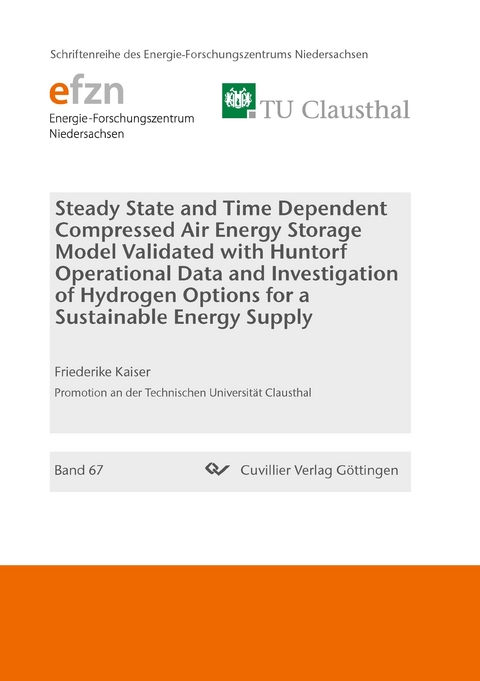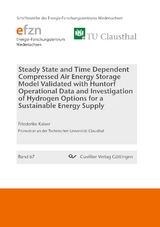Steady State and Time Dependent Compressed Air Energy Storage Model Validated with Huntorf Operational Data and Investigation of Hydrogen Options for a Sustainable Energy Supply
Seiten
2020
Cuvillier Verlag
978-3-7369-7341-1 (ISBN)
Cuvillier Verlag
978-3-7369-7341-1 (ISBN)
- Keine Verlagsinformationen verfügbar
- Artikel merken
Wind power and photovoltaic energy play a significant role in sustainable energy systems. However, these two renewable energy sources do not generate electrical energy on demand and are subject to natural fluctuations. Thus, the need for compensatory measures arises. Compressed air energy storage power plants (CAES) are a possible solution to providing negative and positive control energy in the electric grid. However, in contrast to other energy storage devices such as pumped hydro energy storage or batteries, the storage medium compressed air hardly contains any energy (or more precisely: enthalpy). Yet, compressed air storage allows the operation of highly efficient gas turbines, which are not only particularly fast available but also achieve better efficiency than combined cycle power plants used today, as illustrated by the example of the modern gas and steam power plant Irsching with ηtc = 60%from 2011 compared to the 20 years older McIntosh CAES with ηtc = 82.4 %.
In this thesis, the calculation methods for the thermodynamics of the CAES process are presented and validated by measured data from the operations of the CAES power plant Huntorf. Both the steady state and the dynamic (time-dependent) analyses of the process take place. The characteristic value efficiency is discussed in detail, since numerous different interpretations for CAES exist in the literature. A new calculation method for the electric energy storage efficiency is presented, and a method for the calculation of an economically equivalent electricity storage efficiency is developed. Consideration is given to the transformation of the CAES process into a hydrogen-driven and, thus, greenhouse gas-free process. Finally, a model CAES system is tested in a 100 % renewable model environment.
Consequently, it can be stated that in the steady-state thermodynamic calculation in particular, the consideration of realistic isentropic efficiencies of compressors and turbines is essential to correctly estimate the characteristic values of the process. Furthermore, a steadystate view should always be accompanied by dynamic considerations, since some process characteristics are always time-dependent. The simulation shows that by mapping transient operating conditions, the overall efficiency of the system must be corrected downwards. Nevertheless, in the model environment of a 100 % renewable energy system, it has been shown that a CAES is a useful addition that can provide long-term energy storage.
In this thesis, the calculation methods for the thermodynamics of the CAES process are presented and validated by measured data from the operations of the CAES power plant Huntorf. Both the steady state and the dynamic (time-dependent) analyses of the process take place. The characteristic value efficiency is discussed in detail, since numerous different interpretations for CAES exist in the literature. A new calculation method for the electric energy storage efficiency is presented, and a method for the calculation of an economically equivalent electricity storage efficiency is developed. Consideration is given to the transformation of the CAES process into a hydrogen-driven and, thus, greenhouse gas-free process. Finally, a model CAES system is tested in a 100 % renewable model environment.
Consequently, it can be stated that in the steady-state thermodynamic calculation in particular, the consideration of realistic isentropic efficiencies of compressors and turbines is essential to correctly estimate the characteristic values of the process. Furthermore, a steadystate view should always be accompanied by dynamic considerations, since some process characteristics are always time-dependent. The simulation shows that by mapping transient operating conditions, the overall efficiency of the system must be corrected downwards. Nevertheless, in the model environment of a 100 % renewable energy system, it has been shown that a CAES is a useful addition that can provide long-term energy storage.
| Erscheinungsdatum | 07.01.2021 |
|---|---|
| Reihe/Serie | Schriftenreihe des Energie-Forschungszentrums Niedersachsen (EFZN) ; 67 |
| Verlagsort | Göttingen |
| Sprache | englisch |
| Maße | 148 x 210 mm |
| Themenwelt | Technik ► Elektrotechnik / Energietechnik |
| Schlagworte | Abgase • Battery • Bergbau • black start ability • Brennstoff • CAES • Carnot-Wirkungsgrad • Combustion • Compressed Air • compressed air storage power plant • Current Fluctuations • Drosselklappe • Druckluft • Druckluftspeicherkraftwerk • Efficiency • Effizienz • electricity generator • Elektrizitätsgenerator • Energiebilanz • Energiefluss • Energiepreise • Energiequelle • Energiespeicher • Energiesystem Simulation • Energy balance • energy flow • energy prices • energy source • Energy Storage • Energy system simulation • Enthalpie • Entropy • Erneuerbare • Exergiebilanz • Exhaust gases • fuel • Gaskraftwerk • Gas power station • Greenhouse Gases • Hochlaufzeit • Huntorf • Hydrogen • Hydrogen combustion • Ideales Gas • Kraftwerk • Leistungssteuerung • mcintosh • Phasenschieber • Photovoltaik • Power Control • Power-to-Heat • Ramp up time • reales Gas • Regelenergie • renewable energy • Salzkaverne • Schwarzstartfähig • Sektorkopplung • Silobrennkammer • silo combustion chamber • Sole • Solution mining • Speichermedium • storage medium • Stromproduktion • Stromschwankungen • Systemdienstleistung • thermal transfer unit • thermodynamics • Thermodynamik • the throttle • Treibhausgase • Turbine • Wärmeübertragungseinheit • Wasserstoff • Wasserstoffverbrennung • Windenergie • Wirkungsgrad |
| ISBN-10 | 3-7369-7341-1 / 3736973411 |
| ISBN-13 | 978-3-7369-7341-1 / 9783736973411 |
| Zustand | Neuware |
| Haben Sie eine Frage zum Produkt? |
Mehr entdecken
aus dem Bereich
aus dem Bereich
DIN-Normen und Technische Regeln für die Elektroinstallation
Buch | Softcover (2023)
Beuth (Verlag)
86,00 €
Kolbenmaschinen - Strömungsmaschinen - Kraftwerke
Buch | Hardcover (2023)
Hanser (Verlag)
49,99 €




